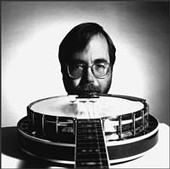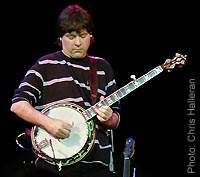Todays Pioneering Banjo Players
Since Bill Keith, there have been a few banjoists appear that have
pushed the banjo into new venues and genres. Building upon his work
along with others, these players have distinguished themselves as todays
pioneers of the five string.
Their music extends way beyond bluegrass, pushing into jazz, rock,
and creating a whole new genre of acoustic fusion. Many traditionalists
feel they put the banjo in places its not meant to go, but the audience
keeps coming to hear these amazing banjoists play their music.
|

Tony Trischka
|
BORN: January 16, 1949, Syracuse, NY Tonys interest in the banjo was created
by John Guards playing in the Kingston Trio in 1963. In 65 he joined a band
The Down City Ramblers, where he remained until 71 when he joined Country
Cooking and debuted his first recordings. Tonys career includes several
bands, broadway shows ,movie soundtracks, and many albums.
|
|
Hes authored some of the best instructional books on banjos written.
Hes also taught many banjo players, including Bela Fleck and Tony Furtado. Tony has been
called a walking encyclopedia for banjo history as well. In many of his shows
he plays on replica old banjos, demonstrating all banjo styles and techniques.
Hes truly an amazing banjoists from every perspective, as a player,
teacher and student of its history.
|
|
Bela Fleck was born in New York City on July 10, 1958.
Like many players his first exposure to the banjo was hearing
Earl Scruggs on the Beverly Hillbillies.
His first banjo came at age 15.
He had been playing folk guitar. but when he got into banjo he leaped
into playing at an amazing rate.
After highschool he moved to Boston to play in the band Tasty Licks,
fronted by Jack Tottle. He was 19.
|
 Bela Fleck
Bela Fleck
|
In this learning time, he only took lessons from three people -
Erik Darling, Marc Horowitz, and Tony Trischka.
He cites Sting and Chick Corea as influences.
Bela gained some recording experiences with Jack Tottles Tasty Licks
and also was in a band called Spectrum, until Sam Bush offered him
a job playing with his rebuilt band Newgrass Revival.
He played with that band for 9 years, then the band decided to split up.
He then formed his own band The Flecktones,His success has continued from there.
Bela also has helped to popularize electric banjos. Deering makes the one
he uses, but recently the Swan Comapany began offering a full line of
electric banjos. This concept of electrifying banjos is old, as mentioned
earlier in this history Eddie Peabody devised his Banjoline in the 60s.
At first the concept of selling an electric instrument that boasts of
sounding as good as a fine acoustic seemed a bit strange to me.
Then I gave some thought to large venues played by some of these banjoists
today and realized as loud as an acoustic banjo is, thousands cannot
hear it at a concert without amplification. I will also say, at the risk
of being labeled a fencebuilder, I have yet to hear an electric banjo
that actually sounded acoustical, but as the banjo has improved from turtle
shells and skins, to callabash gourds and skins to todays machines, in time
I'm sure that technology will provide for that.
|
MORE OF TODAY'S BANJOS' PIONEERS
I'd like to mention a few more of todays players that have caught my attention
as banjo pioneers, much like Bela and Tony.
Dave Crissler is pushing banjo far into traditional jazz. You an sample his
work at his own website Bop Jo Central
he has real player files for you listening pleasure and CDs available to order.
While you're there take time to check out James McKinney. James mixes
Scruggs, and Keith style in a way that appears flawless. I am quite
amazed at his ability. He bridges both traditional bluegrass and some
more eccletic banjo playing seamlessly.
All of these men and many more like them continue to raise the bar of banjo
music and are carving the paths for future players that will follow.
MORE ABOUT |
|

